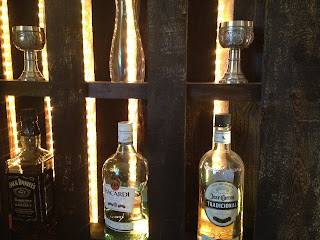Here are the unframed paintings. Pretty blah.
Ok, So then I picked up some supplies from home depot. I had them cut some lightweight board to fit the size I wanted. One of the paintings is 30x40 and the other is 36x48. I decided it would be easiest to make a 5 inch frame, so I had the man cut the boards to 40x50 inches for the smaller painting and 46x58 inches for the larger painting. I also picked up some door molding which is about $1.15 per foot. I had them cut that into smaller pieces because the large pieces were 14 feet long. I also purchased some screws (about 1 inch long), hanging wire, adhesive for the wood, plastic drop cloth, cheap paint brushes, spray paint, and decorative wood embellishments for the corners of the frames (so as to avoid having to cut precise 45 degree angles). I purchased some fabric and Modge Podge (mat) from Hobby Lobby as well. You may or may not need this depending on your preference (see below). You could use paint instead, but I really liked the effect.
drop cloth, screws, paint brushes, contact cement, spray paint, and wooden embellishments.
door molding.
Next you will want to place the embellishments on the corners of the board, and mark where you need to cut the door molding (if it was not already cut to size). Make sure to place all the pieces on the board to make sure they line up appropriately.
Then lay out all the pieces on your drop cloth and spray them ( or paint them with regular paint) whatever color you want. I did two coats. Don't forget the long edges.
Next I cut strips of fabric to place where the wood would be exposed once the molding and painting is in place. I chose to do it this way so that I wouldn't have to buy so much fabric. I used a small subtle pattern which looks like a solid from far away. This is the part where you could use paint or decorative paper, or whatever you want. Then I put matte Modge Podge under and over the fabric, careful to work out all the wrinkles.
Next lay the dried molding on the edges to make sure you don't need to add anymore strips of fabric. If it is a good fit. Place the painting on it as well to make sure the inner margins are good.
Then use the contact cement to glue the molding and embellishment pieces in place. Here is where I would have changed what I did - get some clothes pins to help keep the molding in place as it dries. I used free weights and other heavy things to help with this because I didn't have any clothes pins. Also - make sure your board is the straightest one available. Otherwise, it is really hard to get the molding to stick as it is not flexible and does not want to bend with the board.
When that is dry ( I'd give it at least 24 hours with the weights/clothespins). I didn't have the patience to wait this long and I had to re-glue. Just don't do it. Anyway, carefully stand up the frame and measure the desired distance to place the screws into the back. I did 5 1/2 inches down and towards the middle because I used the screw that was then pointing through to the front of the frame to hold on the actual canvas.
Then attach hanging wire and make sure the wire measures so that if it is pulled taught in the middle as if it were hanging, the wire doesn't stick up over the frame.
Then flip the frame over and carefully place the canvas where it needs to be positioned. Measure all the way around to make sure the painting is centered. If you placed your screws correctly, the pointy end should be positioned so that the wood of the canvas will be over the screw tips. Then use a mallet (or anything blunt that won't damage the canvas) to hammer the canvas into the screw tips. This is all you need to hold the canvas up. Lastly, after this, make sure to paint the sides of the big board so that it is not still wood color.
I made two giant frames. Or faux frames, I guess. Each cost less than $50, and I still have extra molding that I can take back to Home Depot. The difference in the living room is drastic. I think I will keep using this technique in the future.
Here are some comparison shots of before and after.
That's all for today.




























